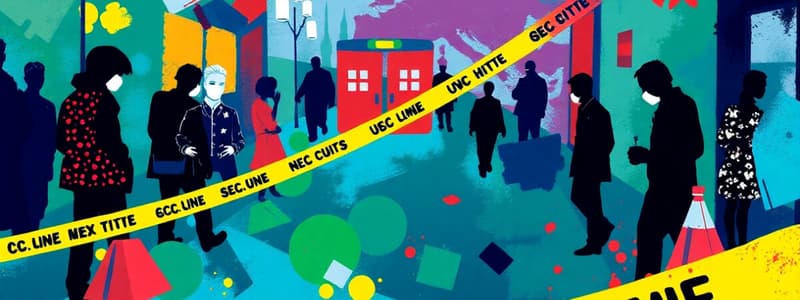Podcast
Questions and Answers
What is one of the first actions first responders should take when arriving at a crime scene?
What is one of the first actions first responders should take when arriving at a crime scene?
- Collect all evidence found
- Determine the cause of death
- Interview witnesses immediately
- Set up an outer perimeter larger than the crime scene (correct)
How should access to the crime scene be controlled?
How should access to the crime scene be controlled?
- Open the scene to all personnel to gather information
- Only allow undercover officers to assess the scene
- Keep the scene accessible for media coverage
- Allow only authorized individuals to enter (correct)
What should be done regarding personnel who enter and exit the crime scene?
What should be done regarding personnel who enter and exit the crime scene?
- Documentation is unnecessary if the scene is secure
- Only the first responders need to be documented
- They should not be logged to keep the process efficient
- They must fill out a detailed access log (correct)
Which practice is essential to prevent contamination of evidence?
Which practice is essential to prevent contamination of evidence?
Why is communication important among teams at a crime scene?
Why is communication important among teams at a crime scene?
What is the primary purpose of crime scene management?
What is the primary purpose of crime scene management?
Which of the following is NOT a responsibility of the first responders at a crime scene?
Which of the following is NOT a responsibility of the first responders at a crime scene?
How does effective crime scene management improve team collaboration?
How does effective crime scene management improve team collaboration?
What aspect of crime scene management helps to prevent wrongful convictions?
What aspect of crime scene management helps to prevent wrongful convictions?
Which step is crucial for first responders to take to maintain the crime scene's integrity?
Which step is crucial for first responders to take to maintain the crime scene's integrity?
Which of the following actions should first responders take immediately upon arrival at a crime scene?
Which of the following actions should first responders take immediately upon arrival at a crime scene?
What is one of the key benefits of documenting the crime scene through notes and photographs?
What is one of the key benefits of documenting the crime scene through notes and photographs?
What is a major consequence of failing to properly preserve evidence at a crime scene?
What is a major consequence of failing to properly preserve evidence at a crime scene?
Flashcards are hidden until you start studying
Study Notes
Crime Scene Management
- Involves a systematic process for securing, preserving, and documenting crime scenes to prevent evidence contamination or loss.
- Steps include securing the area, identifying potential evidence, documenting through notes, photographs, and sketches, and collecting, preserving, and transporting evidence.
Significance of Crime Scene Management
- Preservation of Evidence: Maintains evidence integrity and prevents contamination.
- Event Reconstruction: Assists investigators in accurately reconstructing the crime scene.
- Legal Admissibility: Properly handled evidence ensures it can be used in court.
- Thorough Investigations: Guarantees collection of all relevant evidence.
- Prevention of Miscarriage of Justice: Upholds evidence integrity to avoid wrongful convictions.
- Team Collaboration: Enhances coordination between forensic and legal teams.
Roles and Responsibilities of First Responders
- Securing the Scene: Must control access and ensure safety to prevent contamination.
- Medical Assistance: Provide immediate care for injured individuals while safeguarding evidence.
- Preserving Evidence: Avoid disturbances and protect fragile or time-sensitive evidence.
- Establishing a Perimeter: Set up boundaries to restrict unauthorized access.
- Notifying Authorities: Promptly inform investigators and crime scene units to initiate investigations.
- Documenting Initial Observations: Record observations about the scene, individual positions, and notable evidence.
- Detaining Suspects/Witnesses: Secure suspects or witnesses for questioning by investigators.
- Communication: Maintain clear communication with law enforcement and forensic teams for coordinated investigations.
Securing the Crime Scene
-
Establishing and Maintaining the Perimeter:
- Create an outer perimeter larger than the immediate scene to contain potential evidence.
- Adjust perimeter boundaries based on evidence discovered during the investigation.
- Use physical barriers like tape and vehicles to mark the perimeter.
- Post guards to monitor entry and exit points for scene integrity.
-
Controlling Access and Managing Personnel:
- Maintain an access log detailing personnel entering and exiting, including time and purpose.
- Limit scene access to authorized individuals, such as crime scene investigators and key law enforcement.
- Implement protocols to minimize contamination, including protective clothing like gloves and shoe covers.
- Properly brief investigative teams upon arrival to ensure role clarity and respect for boundaries.
- Ensure continuous communication for updates regarding perimeter changes and access management.
Studying That Suits You
Use AI to generate personalized quizzes and flashcards to suit your learning preferences.




